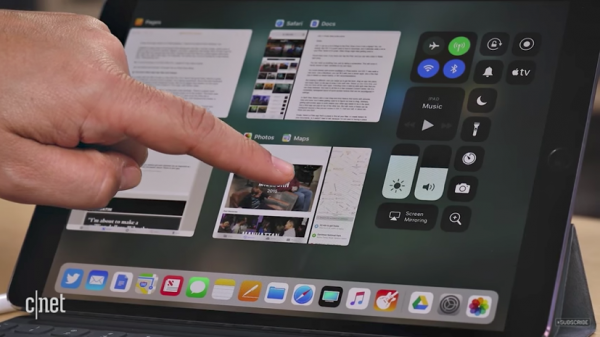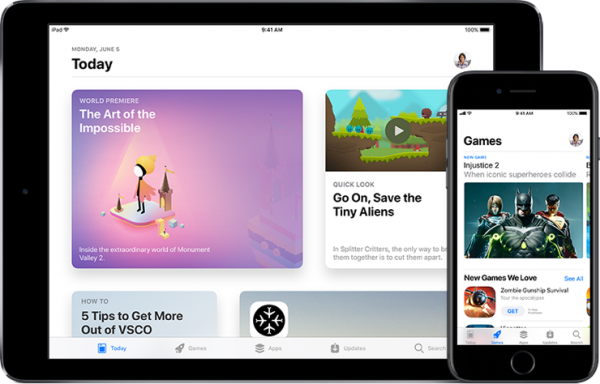Apple is poised to release a new version of its mobile operating system known as iOS 11 as soon as next month. This new iOS release is set to introduce some significant changes to the platform that will bring extra power and functionality to the apps that upgrade – will your app be among them?
First Things First – Will Your App Work on iOS 11?
Before we talk about all the awesome new features you’ll want to make use of in your apps going forward, let’s get the biggest thing out of the way – will your existing apps work with iOS 11? The answer is “maybe”.
iOS 11 Drops 32-Bit App Support
Beginning with iOS 11, many apps in the app store will stop working completely. Got an old app you’ve had for years that’s never been updated? That’s the most likely one to stop working. If you’ve been seeing warnings stating that “This app will not work with future versions of iOS” with any of your apps, be prepared for them to be totally unavailable as soon as you update your device to iOS 11. If these apps are critical to your daily functioning, or to your business as a whole – don’t upgrade to iOS 11 until you’ve gotten an app update and that message no longer appears.
The reason these older apps will stop working with iOS 11 is that iOS 11 is the first version of iOS to no longer support 32-bit applications. Original iOS apps were all 32-bit apps. In September of 2013 Apple released iOS 7, which was the first version of iOS to support 64-bit applications – something the A7 chip, introduced with the iPhone 5S, benefited from. This is the main reason why iOS 11 does not support iPhone 5 or older iPad devices – this is the final move to everything being 64-bit on iOS. This will eventually reduce overall package sizes of apps and remove other complexities of Apple, and developers, supporting both 32-bit and 64-bit versions of the same app.
If your app was initially released after February, 2015, or your last app update was submitted after June, 2015 then you should have nothing to worry about as Apple has been requiring 64-bit binaries since those times. If, however, your app hasn’t been updated since early 2015, be prepared for it to stop working for anyone using iOS 11.
iOS 11 Drops First Party Support for Facebook and Twitter Integrations
In iOS 6, Apple released its Social Library for integrating with social platforms including Twitter and Facebook from within your apps. With iOS 7, Apple added Flickr and Vimeo support to its Social Library. According to recent reports, these social integrations will be removed from iOS 11, meaning that native Twitter/Facebook share sheets will go away, and depending on how your social integration was done, that may break as well. Twitter has released documentation on migrating away from using the iOS Social Library, and Facebook’s documentation covers how to integrate its SDK without using the likely soon-to-expire iOS Social Library. Luckily, most developers have moved away from relying on Social Library, instead pushing users to authenticate within the social apps themselves or with web view logins, so this likely won’t affect a majority of apps – but it’s definitely worth checking.
iOS 11 Introduces New UI Tweaks
Like most iOS updates, there are a number of cosmetic changes to the UI. These include design changes to make fonts larger and bolder, lines darker, and other miscellaneous tweaks. Most notably are the larger sizes for navigation bar title text. If your app was built using native controls and factoring in proper guideline constraints, then your app will simply inherit these changes. If, however, your app was built using a non-native HTML5 platform for example, or expecting a specific navigation bar height, you may find your app not rendering properly until you make updates and publish a new version of your app. The best way to find out? Try out your app today with the latest iOS 11 beta release.
What’s New and Exciting in iOS 11?
Detailing all the new features coming to iOS 11 is quite an arduous task, and perhaps best left to sites that have already done the work. Instead, here are the top-level changes that will likely have the biggest effect on both enterprise and consumer-focused apps alike:
A Dedicated File App and Document System
One of the biggest changes introduced in iOS 11 is the introduction of a new Files app and its underlying file system. Users will now be able to access their files in one consolidated location, be able to launch those files directly with any apps that are registered as handling a given file type, and have those files stored locally or synchronized with services such as iCloud Drive, Box, and Dropbox. This brings a major missing piece of desktop computing to iOS – finally.
What makes this new feature so powerful is that it removes significant complexity in syncing of documents between devices, users, and apps. Imagine having multiple line-of-business apps that interact with a common set of files on the device or in the cloud, or exposing documents from your app that users can then modify or view within another app of their choosing. Hours of time spent implementing document syncing strategies and services could now potentially be avoided and handled by the underlying file system giving app developers more time to focus on the core competency of their apps.
Augmented Reality (AR) Makes Huge Leaps
Perhaps the most futuristic features of iOS 11 are found in the augmented reality space via the new aptly named ARKit. ARKit brings major advancements in augmented reality, accomplishing things which were previously impossible to create without a team of computer scientists and AR specialists. Scenarios such as measuring the physical area of a room, or dragging a virtual tape measure across a surface are now feasible, even when the initial point of the action in the camera view has gone off-screen, via what Apple calls Visual Inertial Odometry (VIO). These exciting advancements make using AR much more powerful and useful, and bring truly powerful tools to line of business and consumer centric apps.

Productivity on iOS and iPad Continues to Improve
Many businesses are finding that iPads and Android tablets are all many employees need to be effective in their job role. With iOS 11, iPads become even more powerful productivity tools. While the aforementioned new file system in iOS 11 brings a lot of potential productivity gains to the workplace, Apple is also bringing a new MacOS-like persistent bottom dock bar as well as drag-and-drop features to the iPad. These new features will allow more power-user type scenarios such as working between multiple apps to accomplish a task, and quickly sharing information between apps. These features combined with keyboard attachments are likely to accelerate iPad usage within businesses by enabling more desktop like experiences.

Business Chat via iMessage
While this feature doesn’t inherently require having an app, it does offer a lot of potential value for businesses trying to service their customers. Beginning with iOS 11, companies can become first tier citizens in the messaging space. Imagine your customer being able to contact you via iMessage straight from your entry on Apple Maps, or kick off that conversation from your mobile app. Not only can customers directly communicate with companies for support, but perhaps even more powerfully for sales as well.
Via the iMessage app users will be able to talk to a representative, make choices from a list of options, schedule appointments, buy products, track shipments, and more. While this feature is relatively exclusive at this point and requires registration and approval from Apple, we believe it is safe to assume that there will be a lot of growth in this area in the years to come. Initially Business Chat will support LivePerson, Salesforce, Nuance, and Genesys platforms, however Apple says that it can be integrated with any backend messaging system with the right effort. Perhaps the most interesting innovations in this space will come when paired with both bots and human customer service representatives – only time will tell.
Machine Learning with Core ML
Artificial intelligence and machine learning becomes a top-tier component of iOS with the release of Core ML in iOS 11. Machine learning gives your apps the ability to learn over time and perform tasks that might seem like magic. Some of this has been seen in previous versions of iOS such as the ability to suggest words you might want to type next on your keyboard, or recognizing people’s faces or specific locations from within the Photos app. With Core ML, 3rd party apps now have the ability to bring these functionalities into their own app, without having to hire neural network and AI experts. Some examples of what can be done with machine learning include the ability to detect a user’s emotion from the camera, recognizing the music genre of a song that’s playing, or finding all photos of a specific item from a collection of photos. While machine learning sounds like magic, it’s something that is refined through training over time, and Core ML brings those capabilities to developers in iOS 11.
A Revamped App Store
iOS 11 introduces an All-New App Store for users to find and install apps and games. While this won’t explicitly require work on the app publishers part, it does provide opportunities to make your app stand out more. New features include app subtitles, multiple preview videos, and featuring in-app-purchases within your app.

And More..
There are other items which may be relevant to your business, but aren’t detailed above. These include:
- NFC tag scanning via Core NFC
- QR and barcode scanning via Vision Framework
- PDF viewing via PDFKit
- Username and Password autofill via new text field types
What About the New iPhone?
While iOS 11 is exciting, it is made even more exciting by its release alongside the much-anticipated iPhone 8. According to numerous leaks over the last several months (some from Apple themselves), the iPhone 8 will feature a significant change to its screen – including an edge to edge display, removal of the physical home button, and a camera area that extends down into the screen area.

iPhone 8 illustration found in Apple HomePod pre-release firmware.
If your app was built using native UI layouts and proper use of the iOS layout and constraint system, then chances are your app will “just work” on the new iPhone 8. If, however, your app wasn’t built with native controls, or makes poor use of constraints, you’ll definitely want to keep an eye out for the first opportunity to test your app on the new device – potentially via a future update to the iOS Simulator before release.
In Summary
iOS 11 brings a ton of new features, many of which we didn’t cover in detail here. Most of these features will fall into the category of general improvements across the Notification Center, Lock Screen, Siri, Maps, the keyboard, and more. While these other improvements will likely take iOS another step forward as a platform, we believe the items we’ve called out here will offer businesses new and exciting ways to differentiate their apps and provide an even better experience for their app users. Most importantly of all however, is to ensure that your app will continue to work well with some of the breaking changes that come at the expense of advancing the platform.
